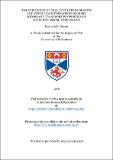The influence of cell population density and virus-transformation on some membrane transport properties of cultured mouse fibroblasts
Abstract
A study has been made of the effect of cell population density and virus-transformation on the transport of K+, inorganic phosphate (Pi) and 2-deoxyglucose in cultured mouse fibroblasts. Normal, untransformed 3T3 show a marked reduction (3-5 fold) in the influx of K+, Pi and 2-deoxyglucose with increasing; cell population density. The reduce-in transport begins at low cell densities and procedes the cessation of cell growth. In contrast, virus-transformed 3T3 cells do not exhibit similar density-dependent reductions in transport. In these cells the influx of K+ and 2-deoxyglucos is independent of cell density. The influx of Pi does decrease with increasing cell density but to a lesser extent and at much higher population densities than in cells. At low cell densities the influx of Pi and 2-deoxglucose in 3T3 cells is only slightly lower than the influx into transformed cells. For K+ the influx in 3T3 cells is slightly higher than in the transformed cells. At higher cell densities the transformed cells exhibit the higher rates of uptake of all three substrates due to the density-dependent transport reduction in the 3T3 cells. Virus-transformation per se does not, therefore, lead to any great increase in transport capacity. In all cases the density-dependent transport reductions are attributable to a decreased Vmax with no change in the Km of the system. The transport sites of normal and virus-transformed cells appear to be qualitatively similar since no significant differences were found for transport Km's between the cell lines. The density-dependent reduction of the K+ influx in 3T3 cells is due to a decrease in "Na-pump" activity with no change in the passive permeability of the cell membrane to K. This reduced "Na-pump" activity is accompanied by a decrease in [K+]i and an increase in [Na+]i. The [K+]i and [Na+]i of virus-transformed cells are not markedly affected by change in cell density. The [K+]i of transformed cells is slightly higher than the [K+]i of untransformed cells at low cell density and almost 2-fold greater than the [K+]i of high density untransformed cells. The cardiac glycoside, ouabain, inhibits Na-K exchange in both untransformed and transformed cells. In the transformed cells the drug also produces a secondary effect ie. a stimulation of K-K exchange. Evidence is presented which suggests that this difference is related known changes in the lipid properties of virus-transformed cell membranes. The inward transport of Pi occurs predominantly via a carrier-mediated, Na-dependent process. A small Na-independent influx of Pi is also present. Preliminary evidence suggests that the outward movement of Pi is also Na-dependent. A model for Na-coupled Pi transport is presented and discussed briefly. The density-dependent reduction of Pi transport in 3T3 cells is due to a decreased Na-dependent influx with no change in the Na-independent component. The addition of fresh complete medium to quiescent 3T3 cells causes a rapid increase in the influx of Pi and 2-deoxyglucose. Fresh medium without scrum does not increase transport. For bott substrates the increased transport results from a higher Vmax with no alteration in Km. Under normal culture conditions this scrum-stimulation of transport is independent of protein synthesis. However, an additional increase in Pi transport occurs when fresh complete medium is added to serum-starved 3T3 cells. This second increase is inhibited by cyclohoximide indicating a requirement for protein synthesis. A model is presented which attempts to explain the effects of serum growth factors in terms of their action on transport systems.
Type
Thesis, PhD Doctor of Philosophy
Collections
Items in the St Andrews Research Repository are protected by copyright, with all rights reserved, unless otherwise indicated.

